- S.D. Eibar ready for maiden La Liga outing
- SD Eibar stengthen ahead of debut La Liga season
- Can ‘Super Mario’ live up to expectations in Madrid?
- MAN IN THE GROUND – Brentford 0 – 4 Osasuna
- Historic Basque derby welcomes S.D. Eibar to La Liga
- Munich to Madrid, via Brazil – Tony Kroos
- Rakitic in Spanish Switch
- Can Spain find redemption in Rio?
- Viva Espana! A season of redemption for Spanish football
- From the old to the new: who can fill the void in years to come for La Roja?
Estadio El Molinón – Home of Real Sporting de Gijón
- Updated: 16 December, 2011
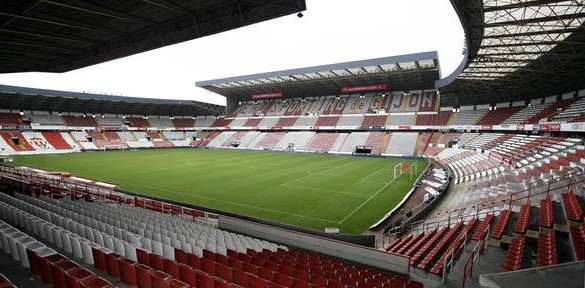
El Molinón may well be the oldest stadium in Spain, but after last year’s makeover it’s not showing its age. In fact, unlike the rest of us, it is undoubtedly getting better with time. The ground staged its first game in 1908 and takes its name from a large watermill that stood on the Rio Piles next the the field.
Formed three years earlier, Real Sporting de Gijón has never quite made it to the level that sees the likes of Valencia CF, Sevilla CF & Athletic Bilbao etc. feed of the scraps that Real Madrid & Barcelona leave behind. That hasn’t deterred their supporters or Sportinguistas as they are known, who are among the most passionate and well-travelled in the country.
Charting the early history of Sporting is very difficult as the club records were lost in the Civil War. We do know that the club played on a number of pitches come grounds in the area of Parque de Isabel la Católicat (the area that surrounds the current stadium) up to 1917 and did use El Molinón as early as 1908.
The stadium saw its first significant development in 1917 when the ground was fully enclosed and a wooden grandstand built. In recognition that this was one of the best grounds in the country, the Spanish Federation staged the 1920 cup final between Barcelona and Athletic Bilbao at El Molinón. In 1924, Sporting Gijon borrowed 75,000 pesetas and bought the stadium and surrounding land for 40,000 pesetas.
The remaining money was invested in improving the stadium and by 1926, El Molinón could boast a full length covered grandstand and a capacity of 20,000. On 22 April 1928, the ground staged its first international match, when La Seleccion played out a 1-1 draw Italy.
In October of 1928, Sporting had made its début in the inaugural second division championship. Disaster struck however on 27 December 1931, when the main grandstand was
completely destroyed by fire following a friendly match with against Racing Santander. The grandstand was rebuilt, but this put huge financial strain on the club and led to a default on the mortgage repayments in 1935.
The situation was left in limbo due to the outbreak of the Civil War, but once order was restored, the Municipality stepped in purchasing the ground on the eve of Sporting’s début in La Primera. Sporting flitted between the first and second divisions for the remainder of the 1940’s & 1950’s and the only change to the stadium during this period was the erection of a concrete cantilevered cover over the north end.
The 1960’s saw Sporting becalmed in La Segunda. The old wooden main stand remained, but behind it stood the unfinished skeleton of the proposed west stand. Towards the end of the decade, El Molinón began to smarten up its act. Floodlights were installed in December 1968 and in January 1969, the municipality agree a four million peseta budget for the addition of a cantilevered cover over the east and south sides.
When completed on 30 November 1969, El Molinón became the first fully covered stadium in Spain. Work didn’t stop there, for in June 1970 the city agreed to spend a further 24 million pesetas on the completion of the main west tibuna. This was opened 10 September 1970 when Athletic Bilbao paid a visit, which coincided with Sporting’s return to La Primera after an 11 year absence.
Sporting spent the bulk of the 1970’s in La Primera, only dropping to La Segunda for the 1976-77 season. On their return, Sporting produced some of the best football the club had witnessed, finishing runners-up to Real Madrid in the 1978-79 season. The final of the Copa del Rey was reached in two consecutive seasons (1981-82), but the club lost out to Barcelona and Real Madrid respectively.
This was and still is the closest the club has come to lifting a domestic trophy. Whilst the club was hitting unprecedented highs, El Molinón was receiving another facelift, this time for Mundial ’82. In 1980, the south stand was extended to include an upper tier of seats and in the summer of 1981, the east side or Tribuna Nueva was built. This was by far the tallest of the four covered stands and dominated the stadium.
There was a problem however. Taken separately, each of the four stands were
perfectly functional, but because of the differing heights and the cack-handed attempt to link them with a series of free-standing hoods, El Molinón ended up being the worst designed stadium in the country. It was an ugly compromise of awkward angles which looked dreadful. The club, the municipality and heaven forbid, Stadium Guru Simon Inglis all hated it. Much has been made of the fact that this was the first and to my knowledge, the only major European stadium designed by a woman, but it was nothing more than bad design.
Despite the debacle of the West Germany v Austria match and its contrived result, the World Cup in Gijon was a success, with over 120,000 attending the three matches. Sporting meanwhile, continued to impress, albeit falling short of landing a trophy. Fourth place in the league was achieved in 1984/85 and again in 86/87, whilst the club regularly qualified for the Uefa Cup.
The stadium was reduced in capacity from 45,000 to 38,000 in 1984 with the addition of seating to the east side. The stadium was converted to an all seat arena in 1997, resulting in a overall capacity of 25,885. Not that the capacity was being tested as Sporting were by now, beginning to struggle. It culminated in a calamitous season in 1997-98 when Sporting finished bottom of La Primera with a total of just 13 points.
Sporting spent the next decade in La Segunda and El Molinón had a few superficial upgrades to the floodlights and the roofs of the south stand and the Nueva Tribuna were reclad, but the stadium still looked awkward and out of place. So did Sporting until they finally got their act together in the 2007-08 season and won promotion back to the top flight.
It was then that the club and the municipality got their heads together to redevelop the stadium. The main change was the demolition of the north stand and the building of new Fondo Norte, which features two tiers and a narrow gallery level high in the vaults of the roof. The main west stand received a new roof and changing rooms.
The refurbishment also saw the building of improved media facilities, new seats were installed throughout and the exterior of the stadium was clad to give it a modern, clean look. With a new capacity of 30,000 El Molinón now looks like a million dollars, or should we say 23 million euros, with the cost of the re-fit being met by the municipality and private investors.
The stadium is no longer an ugly duckling and whilst it might not be quite a white swan, it is a huge improvement on the concrete municipal monstrosity that sprung up in the early 1980’s. Sporting has acquitted themselves well on their return to the top division, with three mid-table finishes.
This season looks a little more precarious and one fears that El Molinón may be witnessing second tier football rather sooner than one had hoped. Which leaves the fair folk of Gijon still as far away from that coveted first trophy as ever. Still the Sportinguistas will continue to believe.
_____________________________
To read more on the footballing stadiums of Spain, visit Chris’s excellent site Estadios de fútbol en España

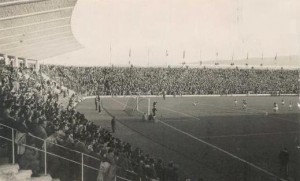
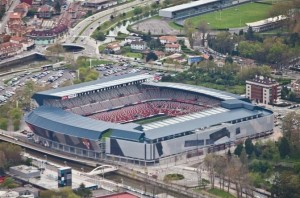
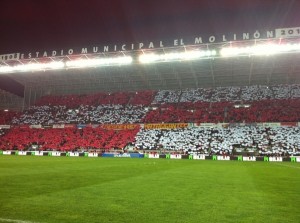
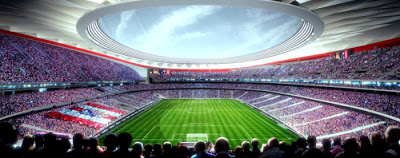
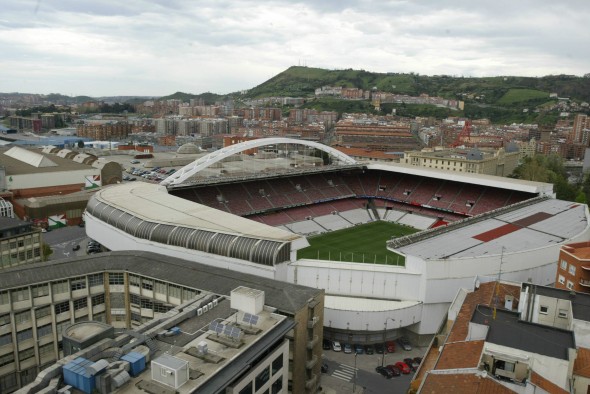

You must be logged in to post a comment Login